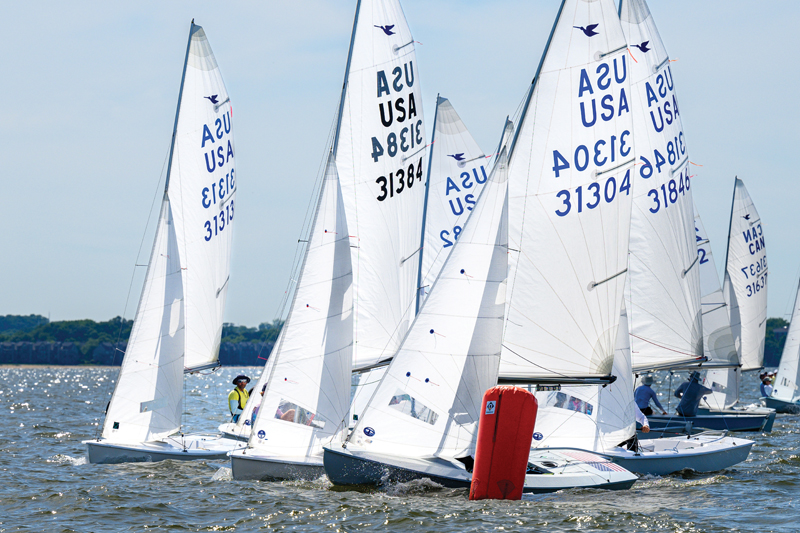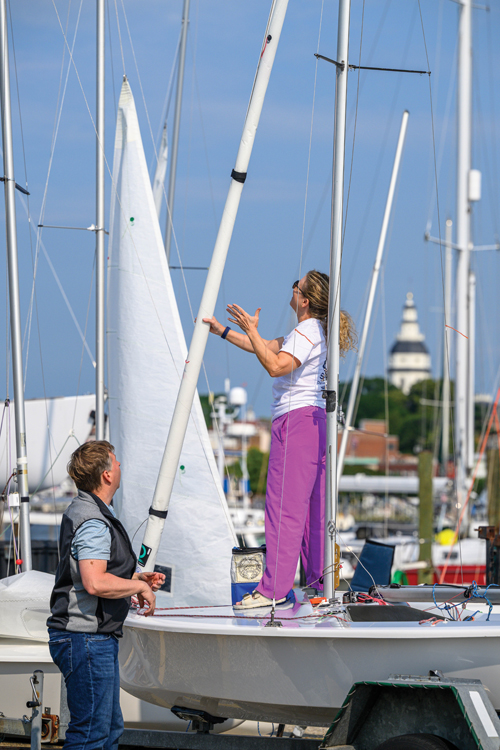A big part of the fun of dinghy racing is being part of the community that makes it happen. In most cases, it’s a heck of a lot more fun to share an experience than to do something by yourself. While the core of this community is time together on the racecourse, things that happen on shore are critical to a vibrant experience as well.

Bolstering your dinghy racing community through conversation.
Last weekend I spent some high-quality time onshore with boats and people that reminded me how fun—and good for our sailing—it is to share time with fellow sailors on land.
The back story: due to a freak weather event (waterspout that came ashore as an EF-0 tornado; nope, not kidding!) that resulted in my ILCA hull landing and sliding on the boat park pavement, I had some significant scratches that needed some care. Doing some boat work on a busy day at my sailing club meant I got to talk with lots of people to help pass the time while wet sanding grumpy spots on the hull. These conversations fell into a few categories—can you bolster your sailing community through conversations like these?

Perspectives on boat work.
I’m pretty finicky about taking care of my 16-year-old boat. It gets a good rinse after every sail, and control line upgrades in recent years help keep it feeling fresh and happy. I’m careful putting it in and out of the water to avoid dragging it over any rough spots, and keeping it polished helps maintain it, too. So having a bunch of scratches—even if only surface-level—on my baby was pretty shocking.
At first, it seemed like a daunting task. I know it’s a small boat, but it seemed like a big problem—and one I wasn’t confident how to tackle. What was the right way to get my boat back in shape? I asked my community. Folks shared suggestions for gelcoat repair sources, and friends and fellow sailors took a peek under the boat sitting on the dolly to diagnose the issues. The bulk of the opinions agreed: The vast majority of the scratches would likely come out with wet sanding and wouldn’t need any more technical work. Buoyed and informed by my community, I bought several different grits of wet or dry paper and headed on down to the boat to smooth things out. It will never be perfect, but it’s a heck of a lot better now.
Collaboration and support.
While I was sanding away, other sailors were out on the water participating in a clinic. One of the participants came back to the dock, wrestling with a bad tiller/traveler interaction that was making tacking a bit of a tangly mess. I was able to take an analytical look at the boat setup and thought about the geometry of how things were set up. I suggested a change and suggested that the sailor make the change and head back out on the water to make sure it worked. That way they’d be ready to go the following day for the second day of the clinic. I know tons of people have helped me over the years, and it felt good to help someone toward a better experience on the water. Sharing knowledge is a great way to build community.
Connections and laughter.
The fun stuff. I got to catch up with some friends I hadn’t seen in quite a while. I got to share some ideas and plans for an upcoming regatta. I heard about some great summer vacations and learned where a few junior program participants were starting college. These are the ties that keep us together!
Dinghy racing knowledge boost.
While I wasn’t part of the conversation, I did overhear some terrific chat among the sailors who returned to shore after the clinic. They were tired after a long practice session, but their enthusiasm for learning from one another was still evident. They were talking sail trim, which side of their practice area had better wind and more current relief, and lots more. Sharing thoughts and suggestions is a key part of making everyone get faster and smarter.
I sure hope the next time I’ll be out on the water rather than doing boat repairs. But even if I’m still on shore, I know I’ll enjoy and benefit from spending time with my sailing community.
by Kim Couranz
About the Author: Kim Couranz has earned several national and world titles in Laser Radials (ILCA 6), Snipes, and Lightnings. She has also raced J/22s, J/24s, and Ynglings on an international level.
Find more sailboat racing stories.




